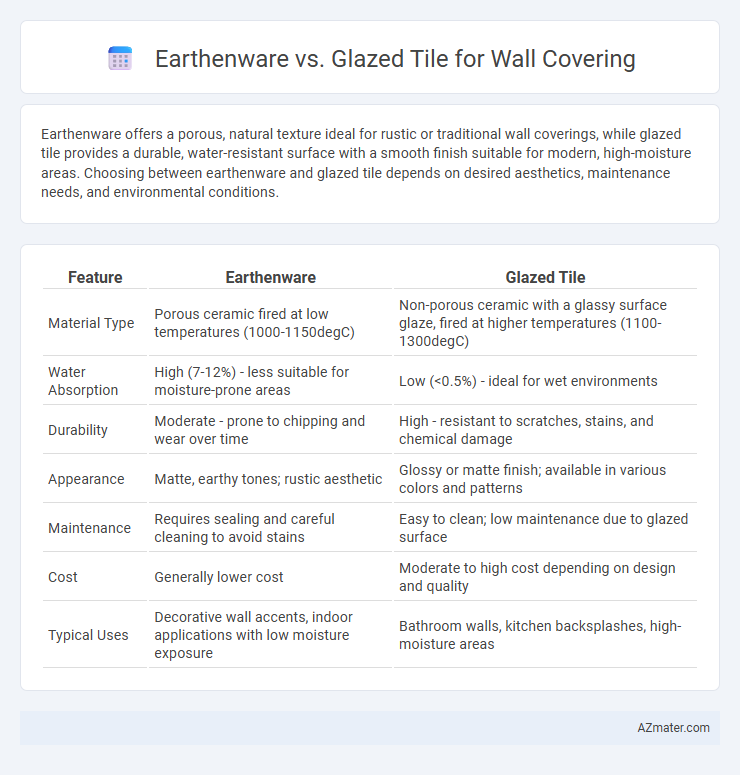Earthenware offers a porous, natural texture ideal for rustic or traditional wall coverings, while glazed tile provides a durable, water-resistant surface with a smooth finish suitable for modern, high-moisture areas. Choosing between earthenware and glazed tile depends on desired aesthetics, maintenance needs, and environmental conditions.
Table of Comparison
| Feature | Earthenware | Glazed Tile |
|---|---|---|
| Material Type | Porous ceramic fired at low temperatures (1000-1150degC) | Non-porous ceramic with a glassy surface glaze, fired at higher temperatures (1100-1300degC) |
| Water Absorption | High (7-12%) - less suitable for moisture-prone areas | Low (<0.5%) - ideal for wet environments |
| Durability | Moderate - prone to chipping and wear over time | High - resistant to scratches, stains, and chemical damage |
| Appearance | Matte, earthy tones; rustic aesthetic | Glossy or matte finish; available in various colors and patterns |
| Maintenance | Requires sealing and careful cleaning to avoid stains | Easy to clean; low maintenance due to glazed surface |
| Cost | Generally lower cost | Moderate to high cost depending on design and quality |
| Typical Uses | Decorative wall accents, indoor applications with low moisture exposure | Bathroom walls, kitchen backsplashes, high-moisture areas |
Introduction to Earthenware and Glazed Tile
Earthenware is a porous, low-fired ceramic material commonly used for wall coverings due to its rustic texture and natural warmth. Glazed tiles feature a vitreous coating that provides enhanced durability, water resistance, and a wide range of colors and finishes suitable for modern interior designs. Both materials offer unique aesthetic and functional benefits, with earthenware favored for traditional settings and glazed tiles preferred for sleek, easy-to-clean surfaces.
Material Composition Differences
Earthenware consists primarily of natural clay fired at lower temperatures, resulting in a porous and less dense material suited for indoor wall coverings, while glazed tiles are made from refined clay and often include silica, feldspar, and kaolin, fired at higher temperatures to create a non-porous, durable surface. The glaze applied to tiles forms a glassy coating that enhances water resistance and allows for vibrant colors and patterns, contrasting with the matte, rustic finish of earthenware. These material composition differences directly impact durability, maintenance, and aesthetic versatility for wall applications.
Visual Aesthetics and Color Options
Earthenware offers a warm, rustic visual aesthetic with natural textures and earthy tones that create a cozy ambiance. Glazed tiles provide a glossy finish with vibrant color options and intricate patterns, allowing for bold and modern wall designs. Both materials enhance interior spaces but cater to different stylistic preferences and color versatility.
Surface Texture and Finish
Earthenware wall coverings offer a warm, rustic surface texture characterized by a slightly porous, matte finish that enhances natural aesthetic appeal while absorbing light softly. Glazed tiles provide a smooth, glossy surface that reflects light vividly, creating a sleek, polished look and offering superior resistance to moisture and stains. Choosing between earthenware and glazed tiles hinges on the desired tactile experience and visual impact, with earthenware favoring organic warmth and glazed tiles emphasizing durability and shine.
Durability and Longevity
Earthenware wall coverings typically offer moderate durability, as their porous nature makes them susceptible to moisture damage and chipping over time. Glazed tiles provide enhanced longevity due to their protective glass-like coating, which resists stains, scratches, and water infiltration. In high-traffic or moisture-prone areas, glazed tiles perform better, maintaining structural integrity and aesthetic appeal significantly longer than unglazed earthenware.
Moisture and Stain Resistance
Earthenware tiles, being porous and unglazed, exhibit lower moisture and stain resistance, making them more susceptible to water absorption and staining in humid or wet environments. In contrast, glazed tiles feature a vitreous coating that significantly enhances their ability to repel moisture and resist stains, providing a durable and low-maintenance surface ideal for bathrooms and kitchens. The glazed surface also inhibits mold and mildew growth, ensuring better long-term hygiene and aesthetic preservation on wall coverings.
Maintenance and Cleaning Requirements
Earthenware requires gentle cleaning with mild soap and water to prevent surface damage, as its porous nature can absorb stains and moisture if not sealed properly. Glazed tiles offer superior resistance to stains and moisture due to their non-porous surface, making them easier to clean with standard household cleaners without risk of damage. Regular sealing of earthenware is essential to maintain durability, whereas glazed tiles generally need less frequent maintenance, reducing overall upkeep time and effort.
Installation Process and Flexibility
Earthenware tiles are generally thicker and heavier, requiring a sturdy substrate and more precise alignment during installation, which can extend the process. In contrast, glazed tiles are thinner and lighter, offering greater ease and speed in installation with more flexibility for intricate patterns or wall contours. The porous nature of earthenware demands sealing before installation to prevent moisture issues, whereas glazed tiles feature a non-porous surface that eliminates this step, enhancing installation efficiency.
Cost Comparison
Earthenware wall coverings typically cost less due to lower material and manufacturing expenses, making them a budget-friendly option for large surface areas. Glazed tiles, with their additional coating process, incur higher production costs resulting in increased retail prices but offer enhanced durability and stain resistance. Choosing between earthenware and glazed tiles depends on balancing upfront investment against long-term maintenance savings.
Ideal Applications and Room Suitability
Earthenware is ideal for rustic or traditional interiors, offering a porous texture best suited for low-moisture areas like living rooms and dining spaces, where its natural warmth enhances ambiance. Glazed tiles provide a water-resistant, durable surface perfect for high-moisture environments such as bathrooms and kitchens, combining easy maintenance with vibrant color options for modern aesthetics. Selecting between earthenware and glazed tiles depends on the balance of moisture exposure, durability requirements, and desired visual effect in each room.

Infographic: Earthenware vs Glazed Tile for Wall Covering
 azmater.com
azmater.com